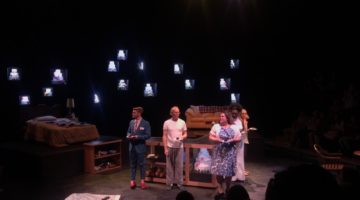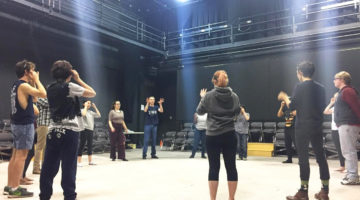 I never expected any Shakespeare play that I would see in my life to end with the cast and audience dancing together on the stage to Gloria Gaynor’s “I Will Survive.” That expectation has now changed after walking out of the University of Nevada, Reno’s production of “Twelfth Night.”
I never expected any Shakespeare play that I would see in my life to end with the cast and audience dancing together on the stage to Gloria Gaynor’s “I Will Survive.” That expectation has now changed after walking out of the University of Nevada, Reno’s production of “Twelfth Night.”
The play follows the story of Viola as she is shipwrecked and separated from her brother, Sebastian. In order to be safe, Viola disguises herself as a man named Cesario and enters the service of Duke Orsino. Several antics ensue throughout the play, leading to comic subplots like Olivia, a countess and the play’s main love interest, falling for Cesario/Viola, creating a love triangle between Olivia, Cesario and Duke Orsino. Several other comic subplots appear throughout the play, but much of the comedy comes from Viola passing herself as a man.
UNR’s Theatre Department brings a twist to “Twelfth Night” by setting the show in the Black Rock Desert instead of the classic Shakespearean setting, Illyria. A bold choice by the directors, but it certainly paid off. The modern setting gives “Twelfth Night” a hometown feel and a deeper connection to its audience. Not only does the setting bring the play into modern times, but it also allows the play to delve deeper into the themes of expression and gender fluidity.
The highest praise must be given to Cabral and McKinney’s direction. Cabral’s insight and staging brought together the artistic vision of Shakespeare on the Playa and brought out the theme of expression throughout the play. Staging and costuming credit goes to McKinney. While the set wass minimal, the lighting and costuming were bright and vibrant. Every character was enhanced due to the dramatic flair brought about by their costuming. Be it a flashy red cape, yellow stockings or a magenta leotard, the costumes helped infuse the culture of the Black Rock Desert into the show.
From beginning to end, the stage is filled with bright, colorful lighting and even more colorful characters. Each actor had a clear character and objectives. Also, each character had a uniqueness to them, be it their laugh, their voice or even the way they walk. With dialogue like Shakespeare’s, I’m glad each cast member was able to bring out the physicality in their characters. It made the show all the more entertaining. Speaking of physicality, credit must be given to Aiden Billharz, the actor who played Feste, a jester and Shakespeare’s staple lighthearted comical character. His acrobatics brought a lot of fun to several scenes, and his constant upbeat persona made the play all the more enjoyable. Other standouts include Marygrace McManus’s Viola/Cesario, Thomas Chubb’s Sir Andrew, and Anna Sather Hart’s Olivia.
Despite the show’s entertainment, there will always be flaws in every show. Being in a round theatre with no microphones made it difficult to hear characters in certain scenes. Also, the dialogue was spoken very fast at points, making it even harder to understand. The cast should continue working on articulation and projection.
Despite these small flaws, “Twelfth Night” was a success for UNR’s Theatre Department. I recommend the show to anyone who can see it. The show runs March 2-4 and March 7-10. All shows start at 7:30 p.m. except for the 1:30 p.m. matinee on Sunday, March 4. Tickets can be purchased at the University of Nevada, Reno’s (UNR) Theatre Department website. I wish all the best to the cast and crew for the rest of the show’s run, and I hope each showing produces a better and better play.












